Mechanical and Tribological Properties of the CrAl/CrAlN and CrAl/CrAlN-(a-CNx) Multilayers Deposited by HIPIMS
Abstract
:1. Introduction
2. Materials and Methods
2.1. Sample Preparation and Film Deposition
2.2. Structure, Morphology, and Chemical Characterization
2.3. Mechanical and Adhesion Properties
2.4. Tribological Properties
3. Results and Discussion
3.1. Structure, Morphology, and Chemical Characterization
3.2. Mechanical and Adhesion Properties
3.3. Tribology Properties
3.3.1. Raman Characterization in Fretting Test
3.3.2. Fretting Regime
4. Conclusions
Author Contributions
Funding
Institutional Review Board Statement
Informed Consent Statement
Data Availability Statement
Acknowledgments
Conflicts of Interest
References
- Ding; X.Z.; Zeng, X.T.; Liu, Y.C.; Fang, F.Z.; Lim, G.C. Cr1-xAlxN coatings deposited by lateral rotating cathode arc for high speed machining applications. Thin Solid Film. 2008, 516, 1710–1715. [Google Scholar] [CrossRef]
- Wang, L.; Zhang, G.; Wood, R.J.K.; Wang, S.C.; Xue, Q. Fabrication of CrAlN nanocomposite films with high hardness and excellent anti-wear performance for gear application. Surf. Coat. Technol. 2010, 204, 3517–3524. [Google Scholar] [CrossRef]
- Tang, J.F.; Lin, C.Y.; Yang, F.C.; Chang, C.L. Influence of nitrogen content and bias voltage on residual stress and the tribological and mechanical properties of CrAlN films. Coatings 2020, 10, 546. [Google Scholar] [CrossRef]
- Berg, G.; Friedrich, C.; Broszeit, E.; Berger, C. Development of chromium nitride coatings substituting titanium nitride. Surf. Coat. Technol. 1996, 86, 184–191. [Google Scholar] [CrossRef]
- Khamseh, S.; Nose, M.; Kawabata, T.; Saiki, A.; Matsuda, K.; Terayama, K.; Ikeno, S. Effect of deposition conditions on the structure and properties of CrAlN films prepared by pulsed DC reactive sputtering in FTS mode at high Al content. Mater. Trans. 2008, 49, 2082–2090. [Google Scholar] [CrossRef] [Green Version]
- Khamseh, S.; Nose, M.; Ueda, S.; Kawabata, T.; Nagae, T.; Matsuda, K.; Ikeno, S. Nanostructured CrAlN Films Prepared at Different Pulse Widths by Pulsed DC Reactive Sputtering in Facing Target Type System. Mater. Trans. 2008, 49, 0810100573. [Google Scholar] [CrossRef] [Green Version]
- Nouveau, C.; Tlili, B.; Aknouche, H.; Benlatreche, Y.; Patel, B. Comparison of CrAlN layers obtained with one (CrAl) or two targets (Cr and Al) by magnetron sputtering. Thin Solid Film. 2012, 520, 2932–2937. [Google Scholar] [CrossRef] [Green Version]
- Tsai, S.H.; Duh, J.G. Microstructure and Corrosion Properties of Multilayered CrAlN/SiNx Coatings. J. Electrochem. Soc. 2010, 157, K89. [Google Scholar] [CrossRef]
- Ipaz, L.; Aperador, W.; Caicedo, J.; Esteve, J.; Zambrano, G. A Practical Application of X-ray Spectroscopy in Ti-Al-N and Cr-Al-N Thin Films. In X-ray Spectroscopy; InTech: Shanghai, China, 2012. [Google Scholar] [CrossRef] [Green Version]
- Kaouther, K.; Hafedh, D.; Lassaad, Z.; Ahmed, B.C.L. Mechanical Characterization of CrN/CrAlN Multilayer Coatings Deposited by Magnetron Sputtering System. J. Mater. Eng. Perform. 2015, 24, 4077–4082. [Google Scholar] [CrossRef]
- Paulitsch, J.; Schenkel, M.; Zufraß, T.; Mayrhofer, P.H.; Münz, W.D. Structure and properties of high power impulse magnetron sputtering and DC magnetron sputtering CrN and TiN films deposited in an industrial scale unit. Thin Solid Film. 2010, 518, 5558–5564. [Google Scholar] [CrossRef]
- Bobzin, K.; Brögelmann, T.; Kruppe, N.C.; Engels, M.; Von Keudell, A.; Hecimovic, A.; Ludwig, A.; Grochla, D.; Banko, L. Fundamental study of an industrial reactive HPPMS (Cr, Al)N process. J. Appl. Phys. 2017, 122, 015302. [Google Scholar] [CrossRef]
- Wu, Z.; Cheng, Z.; Zhang, H.; Xu, Z.; Wang, Y.; Zhou, F. Electrochemical and Tribological Properties of CrAlN, TiAlN, and CrTiN Coatings in Water-Based Cutting Fluid. J. Mater. Eng. Perform. 2020, 29, 2153–2163. [Google Scholar] [CrossRef]
- Wang, X.; Kwon, P.Y.; Schrock, D.; Kim, D. Friction coefficient and sliding wear of AlTiN coating under various lubrication conditions. Wear 2013, 304, 67–76. [Google Scholar] [CrossRef]
- Liu, D.; Ma, H.; Li, H.; Liang, Y. Structure, phase transformation and corrosion resistance of CrAlN/CNx composite multilayer films in NaCl aqueous solution. Ceram. Int. 2019, 45, 24446–24452. [Google Scholar] [CrossRef]
- Tillmann, W.; Dias, N.F.L.; Stangier, D. Tribo-mechanical properties of CrC/a-C thin films sequentially deposited by HiPIMS and mfMS. Surf. Coat. Technol. 2018, 335, 173–180. [Google Scholar] [CrossRef]
- Bakoglidis, K.D.; Schmidt, S.; Greczynski, G.; Hultman, L. Improved adhesion of carbon nitride coatings on steel substrates using metal HiPIMS pretreatments. Surf. Coat. Technol. 2016, 302, 454–462. [Google Scholar] [CrossRef]
- Bakoglidis, K.D.; Schmidt, S.; Garbrecht, M.; Ivanov, I.G.; Jensen, J.; Greczynski, G.; Hultman, L. Low-temperature growth of low friction wear-resistant amorphous carbon nitride thin films by mid-frequency, high power impulse, and direct current magnetron sputtering. J. Vac. Sci. Technol. A Vac. Surf. Film. 2015, 33, 05E112. [Google Scholar] [CrossRef] [Green Version]
- Bakoglidis, K.D.; Glenat, H.; Greczynski, G.; Schmidt, S.; Grillo, S.; Hultman, L.; Broitman, E. Comparative study of macro- and microtribological properties of carbon nitride thin films deposited by HiPIMS. Wear 2017, 370–371, 1–8. [Google Scholar] [CrossRef]
- Terek, P.; Kukuruzović, D.; Kovačević, L.; Miletić, A.; Terek, V.; Škorić, B.; Panjan, P.; Čekada, M. The Influence of CrAlN Coating Chemical Composition on Soldering Resistance in Contact with Al-Si-Cu Alloy. Mater. Proc. 2020, 2, 28. [Google Scholar] [CrossRef]
- Oliver, W.C.; Pharr, G.M. An improved technique for determining hardness and elastic modulus using load and displacement sensing indentation experiments. J. Mater. Res. 1992, 7, 1564–1583. [Google Scholar] [CrossRef]
- Chang, S.Y.; Huang, Y.C. Analyses of interface adhesion between porous SiO2 low-k film and SiC/SiN layers by nanoindentation and nanoscratch tests. Microelectron. Eng. 2007, 84, 319–327. [Google Scholar] [CrossRef]
- Chang, S.-Y.; Lee, Y.-S.; Lu, C.-L. Effect of Plasma Treatments on the Interface Chemistry and Adhesion Strength Between Cu Metallization and SiCN Etch Stop Layer. J. Electrochem. Soc. 2007, 154, D241. [Google Scholar] [CrossRef]
- Huang, Y.C.; Chang, S.Y.; Chang, C.H. Effect of residual stresses on mechanical properties and interface adhesion strength of SiN thin films. Thin Solid Film. 2009, 517, 4857–4861. [Google Scholar] [CrossRef]
- Wang, Q.; Zhou, F.; Yan, J. Evaluating mechanical properties and crack resistance of CrN, CrTiN, CrAlN and CrTiAlN coatings by nanoindentation and scratch tests. Surf. Coat. Technol. 2016, 285, 203–213. [Google Scholar] [CrossRef]
- Mayrhofer, P.H.; Music, D.; Reeswinkel, T.; Fuß, H.G.; Schneider, J.M. Schneider, Structure, elastic properties and phase stability of Cr1−xAlxN. Acta Mater. 2008, 56, 2469–2475. [Google Scholar] [CrossRef]
- Champi, A.; Lacerda, R.G.; Marques, F.C. Thermomechanical properties of the amorphous carbon nitride thin films. Microelectron. J. 2003, 34, 553–555. [Google Scholar] [CrossRef]
- Dong, H.; Oganov, A.R.; Zhu, Q.; Qian, G.R. The phase diagram and hardness of carbon nitrides. Sci. Rep. 2015, 5, 9870. [Google Scholar] [CrossRef] [Green Version]
- Liu, X.L.; Li, Z.H.; Xiao, Q.; Yang, W.B.; Chen, D.Y. Fretting Wear of Co-Cr-Mo Alloys at Elevated Temperatures. J. Mater. Eng. Perform. 2020, 29, 7499–7510. [Google Scholar] [CrossRef]
- Vincent, L.; Berthier, Y.; Godet, M. Testing Methods in Fretting Fatigue: A Critical Appraisal; ASTM International: West Conshohocken, PA, USA, 1992; Volume 1159, pp. 33–48. [Google Scholar]
- Panjan, P. Industrial applications of CrN (PVD) coatings, deposited at high and low temperatures. Surf. Coat. Technol. 1997, 97, 182–191. [Google Scholar]
- Kong, J.Z.; Hou, T.J.; Wang, Q.Z.; Yin, L.; Zhou, F.; Zhou, Z.F.; Li, L.K.Y. Influence of titanium or aluminum doping on the electrochemical properties of CrN coatings in artificial seawater. Surf. Coat. Technol. 2016, 307, 118–124. [Google Scholar] [CrossRef]
- Quintero, O.M.S.; Chaparro, W.A.; Ipaz, L.; Barco, J.E.S.; Beltrán, F.E.; Zambrano, G. Influence of the microstructure on the electrochemical properties of Al-Cr-N coatings deposited by Co-Sputtering method from a Cr-Al binary target. Mater. Res. 2013, 16, 204–214. [Google Scholar] [CrossRef] [Green Version]
- Baseri, N.A.; Mohammadi, M.; Ghatee, M.; Abassi-Firouzjah, M.; Elmkhah, H. The effect of duty cycle on the mechanical and electrochemical corrosion properties of multilayer CrN/CrAlN coatings produced by cathodic arc evaporation. Surf. Eng. 2021, 37, 253–262. [Google Scholar] [CrossRef]
- Lv, Y.; Ji, L.; Liu, X.; Li, H.; Zhou, H.; Chen, J. The structure and properties of CrAlN films deposited by mid-frequency unbalanced magnetron sputtering at different substrate bias duty cycles. Surf. Coat. Technol. 2012, 206, 3961–3969. [Google Scholar] [CrossRef]
- Mohammadpour, E.; Jiang, Z.T.; Altarawneh, M.; Mondinos, N.; Rahman, M.M.; Lim, H.N.; Huang, N.M.; Xie, Z.; Zhou, Z.F.; Dlugogorski, B.Z. Experimental and predicted mechanical properties of Cr1−xAIxN thin films, at high temperatures, incorporating in situ synchrotron radiation X-ray diffraction and computational modelling. RSC Adv. 2017, 7, 22094–22104. [Google Scholar] [CrossRef] [Green Version]
- Zheng, X.H.; Yang, F.E.; Chen, L.; Chen, Z.L.; Song, R.G.; Zhang, X.H. Microstructure and mechanical properties of a-CNx films prepared by bias voltage assisted PLD with carbon nitride target. Surf. Coat. Technol. 2014, 258, 716–721. [Google Scholar] [CrossRef]
- Ferrari, A.C.; Rodil, S.E.; Robertson, J. Interpretation of infrared and Raman spectra of amorphous carbon nitrides. Phys. Rev. B 2003, 67, 155306. [Google Scholar] [CrossRef] [Green Version]
- Ferrari, A.; Robertson, J. Interpretation of Raman spectra of disordered and amorphous carbon. Phys. Rev. B—Condens. Matter Mater. Phys. 2000, 61, 14095–14107. [Google Scholar] [CrossRef] [Green Version]
- Zhao, Z.; Miao, Q.; Liang, W.; Xia, J.; Lin, H.; Qi, Y.; Zuo, S. Effect of CrAl interlayer on adhesion strength of CrAlN coating. Surf. Eng. 2020, 36, 438–446. [Google Scholar] [CrossRef]
- Pérez-Alvarez, J.; Flores-Jiménez, M.; Rivera-Tello, C.D.; Suárez-Martínez, R.; Jimenez, O.; Flores-Cova, L.; Flores, M. Effect of a-CNx top layer on the electrochemical properties of Ta2N/Ta multilayers obtained by HIPIMS. Mater. Lett. 2020, 278, 128454. [Google Scholar] [CrossRef]
- Zhou, F.; Adachi, K.; Kato, K. Comparisons of tribological property of a-C, a-CNx and BCN coatings sliding against SiC balls in water. Surf. Coat. Technol. 2006, 200, 4471–4478. [Google Scholar] [CrossRef]
- Laegreid, N.; Wehner, G.K. Sputtering yields of metals for ar+ and ne+ ions with energies from 50 to 600 ev. J. Appl. Phys. 1961, 32, 365–369. [Google Scholar] [CrossRef]
- Lv, F.; Wen, S.P.; Zong, R.L.; Zeng, F.; Gao, Y.; Pan, F. Nanoindentation study of amorphous-Co79Zr13Nb8/Cr multilayers. Surf. Coat. Technol. 2008, 202, 3239–3245. [Google Scholar] [CrossRef]
- Horwat, D.; Jimenez-Pique, E.; Pierson, J.F.; Migot, S.; Dehmas, M.; Anglada, M. High hardness, low Youngs modulus and low friction of nanocrystalline ZrW2 Laves phase and Zr1−xWx thin films. J. Phys. Chem. Solids 2012, 73, 554–558. [Google Scholar] [CrossRef]
- Kataria, S.; Kumar, N.; Dash, S.; Ramaseshan, R.; Tyagi, A.K. Evolution of deformation and friction during multimode scratch test on TiN coated D9 steel. Surf. Coat. Technol. 2010, 205, 922–927. [Google Scholar] [CrossRef]
- Khlifi, K.; Ben Cheikh Larbi, A. Investigation of adhesion of PVD coatings using various approaches. Surf. Eng. 2013, 29, 555–560. [Google Scholar] [CrossRef]
- Kim, K.H.; Han, D.S.; Kim, S.K. Adhesion properties of arc ion-plated TiN coatings with WC particle size, Co content and surface roughness. Surf. Coat. Technol. 2003, 163–164, 605–610. [Google Scholar] [CrossRef]
- Yang, F.; Yang, S.; Chang, X.; Yang, W.; Song, R. Surface & Coatings Technology Microstructure and properties of DLC/CNx fi lms with di ff erent CNx sublayer thicknesses. Surf. Coat. Technol. 2019, 374, 418–423. [Google Scholar] [CrossRef]
- Shima, M.; Okado, J.; McColl, I.R.; Waterhouse, R.B.; Hasegawa, T.; Kasaya, M. The influence of substrate material and hardness on the fretting behaviour of TiN. Wear 1999, 225–229, 38–45. [Google Scholar] [CrossRef]
- Zhang, D.K.; Ge, S.R.; Qiang, Y.H. Research on the fatigue and fracture behavior due to the fretting wear of steel wire in hoisting rope. Wear 2003, 255, 1233–1237. [Google Scholar] [CrossRef]
- Ramesh, R.; Gnanamoorthy, R. Development of a fretting wear test rig and preliminary studies for understanding the fretting wear properties of steels. Mater. Des. 2006, 27, 141–146. [Google Scholar] [CrossRef]
- Endrino, J.L.; Fox-Rabinovich, G.S.; Reiter, A.; Veldhuis, S.V.; Galindo, R.E.; Albella, J.M.; Marco, J.F. Oxidation tuning in AlCrN coatings. Surf. Coat. Technol. 2007, 201, 4505–4511. [Google Scholar] [CrossRef]
- Rebelo de Figueiredo, M.; Bergmann, C.; Ganser, C.; Teichert, C.; Kukla, C.; Mitterer, C. Adhesion tendency of polymers to hard coatings. Int. Polym. Process. 2013, 28, 415–420. [Google Scholar] [CrossRef]
- Wang, P.; Zhang, W.; Diao, D. Low friction of graphene nanocrystallite embedded carbon nitride coatings prepared with MCECR plasma sputtering. Surf. Coat. Technol. 2017, 332, 153–160. [Google Scholar] [CrossRef]
- Wang, P.; Adachi, K. Low frictions of self-mated CNx coatings in dry and humid inert gas environments. Surf. Coat. Technol. 2014, 258, 1137–1144. [Google Scholar] [CrossRef]
- A Global Methodology to Quantify Fretting Damage|Request PDF, (n.d.). Available online: https://www.researchgate.net/publication/289362712_A_global_methodology_to_quantify_fretting_damage (accessed on 20 July 2023).
- Varenberg, M.; Etsion, I.; Halperin, G. Slip index: A new unified approach to fretting. Tribol. Lett. 2004, 17, 569–573. [Google Scholar] [CrossRef]
- Chaudhry, V.; Kailas, S.V. Fretting studies on self-mated stainless steel and chromium carbide coated surfaces under controlled environment conditions. Wear 2013, 301, 524–539. [Google Scholar] [CrossRef]
- Huq, M.Z.; Celis, J.-P. Expressing wear rate in sliding contacts based on dissipated energy. Wear 2002, 252, 375–383. [Google Scholar] [CrossRef]
- Vingsbo, O.; Söderberg, S. On fretting maps. Wear 1988, 126, 131–147. [Google Scholar] [CrossRef]
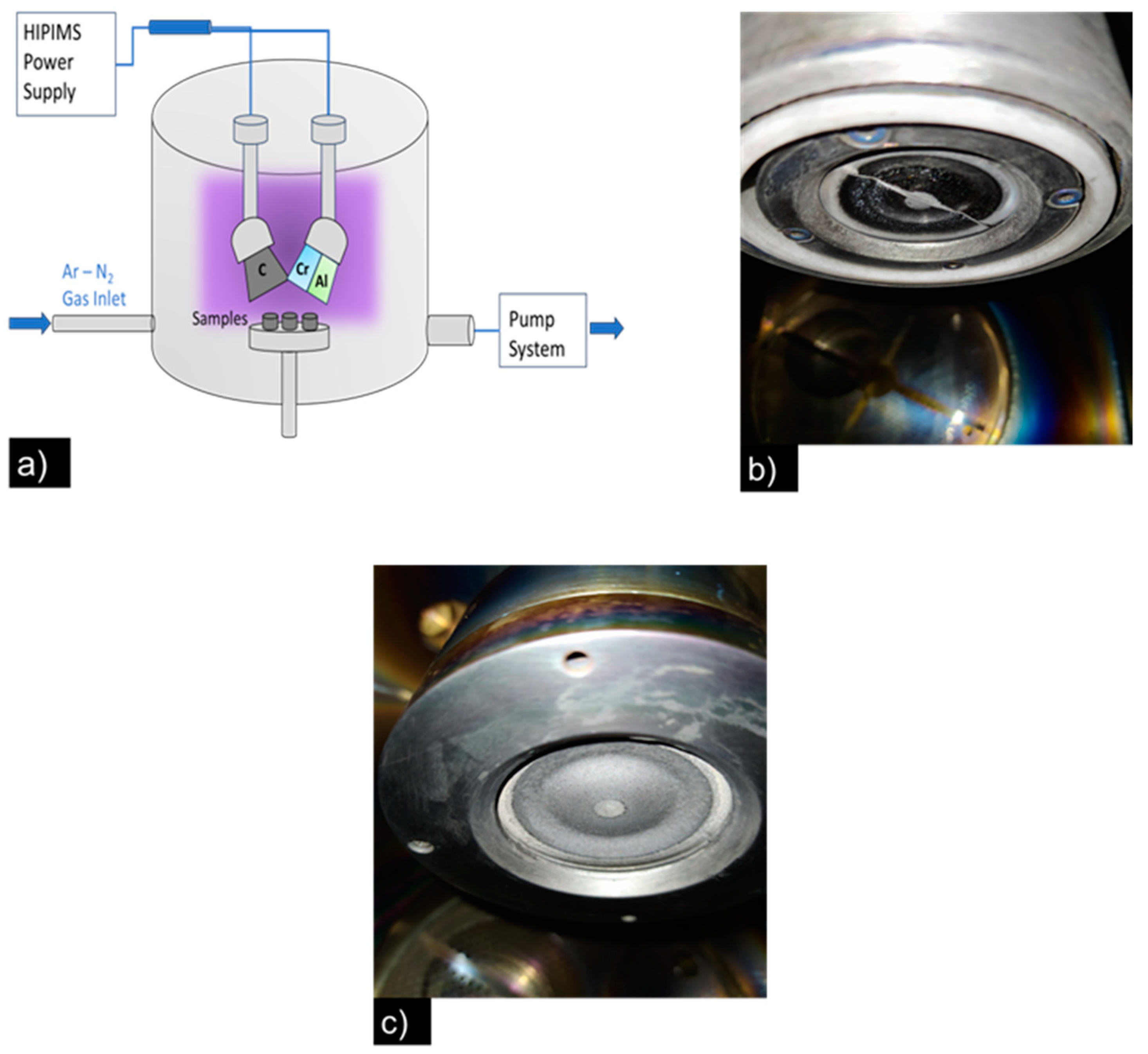

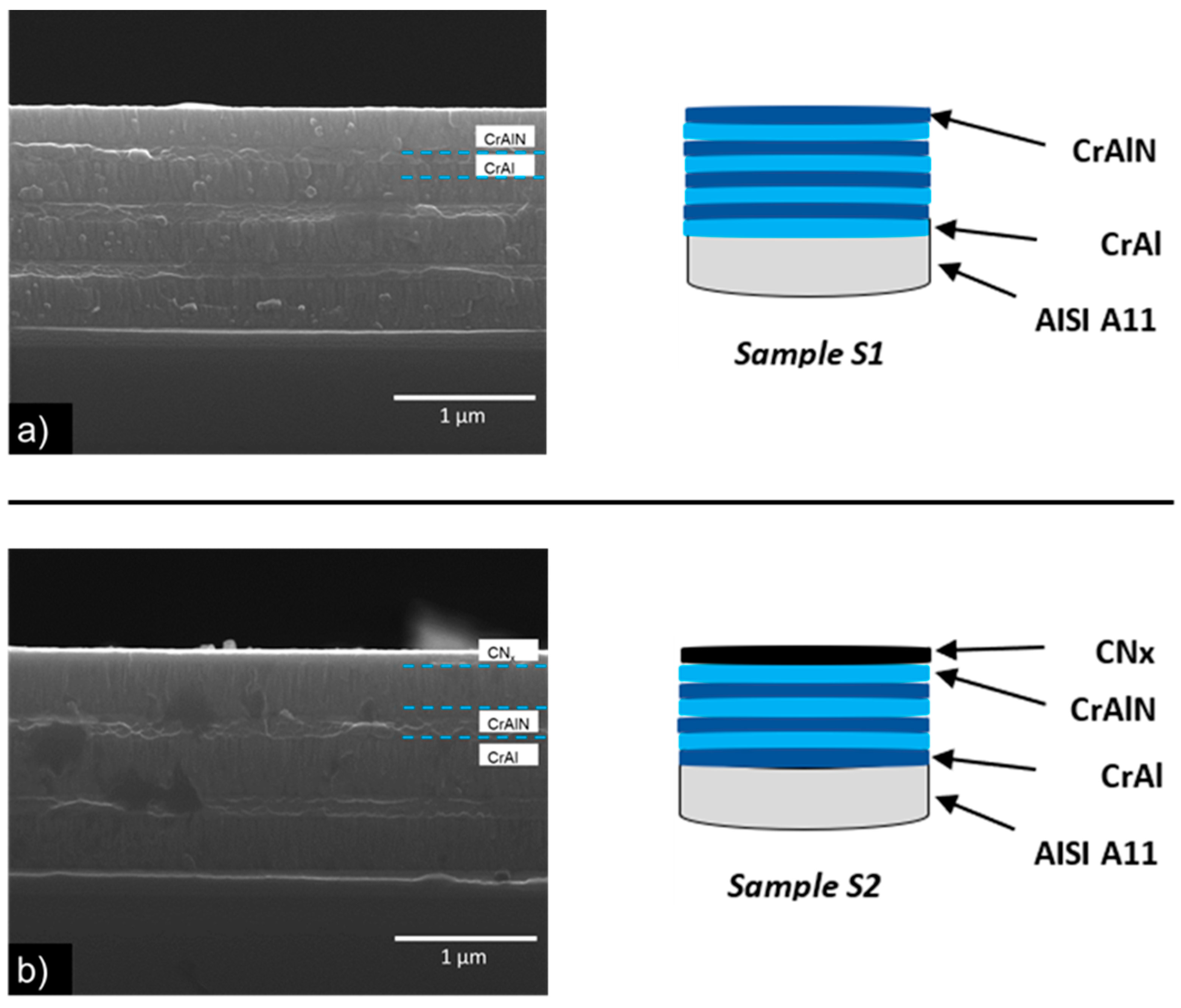
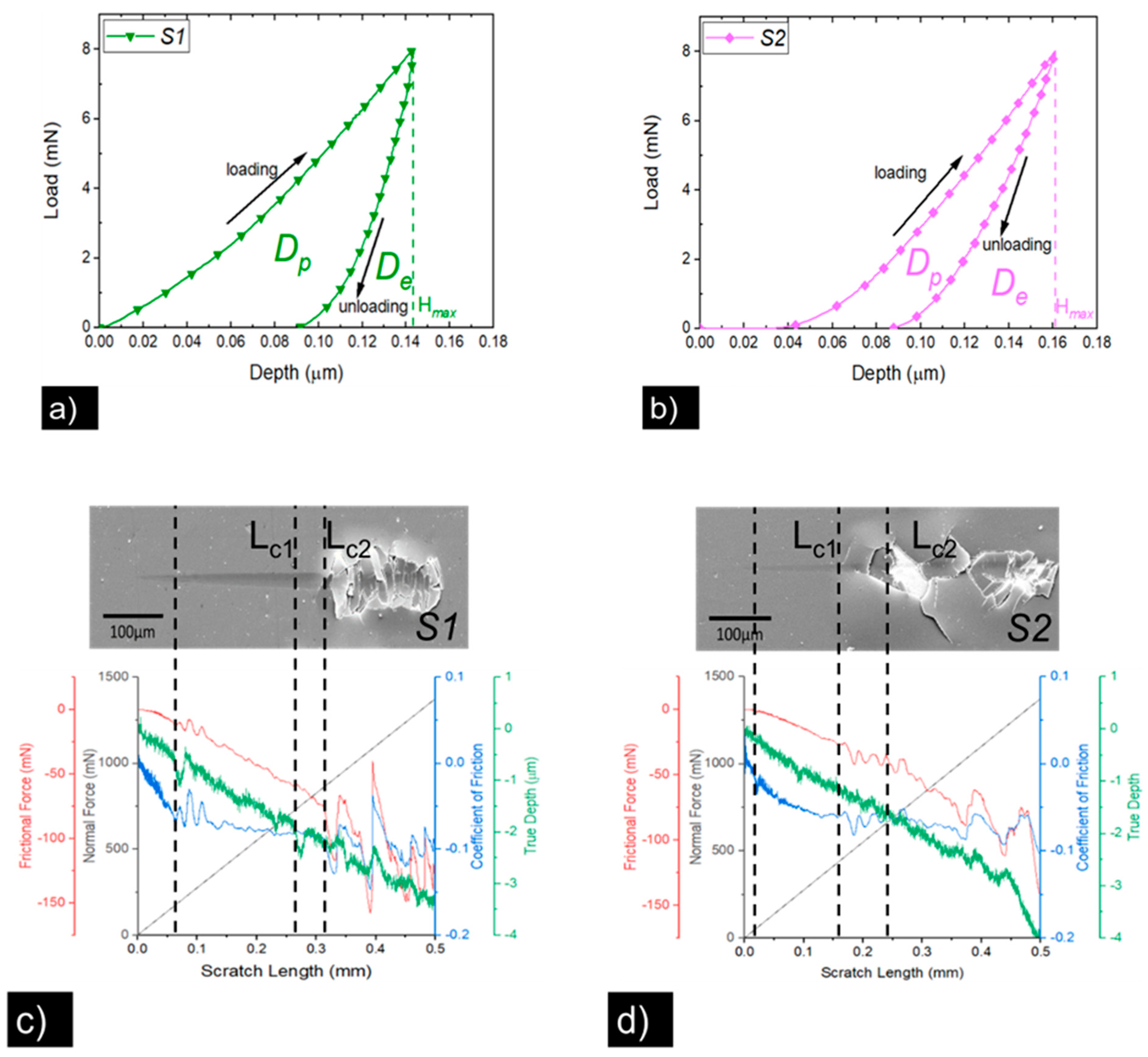
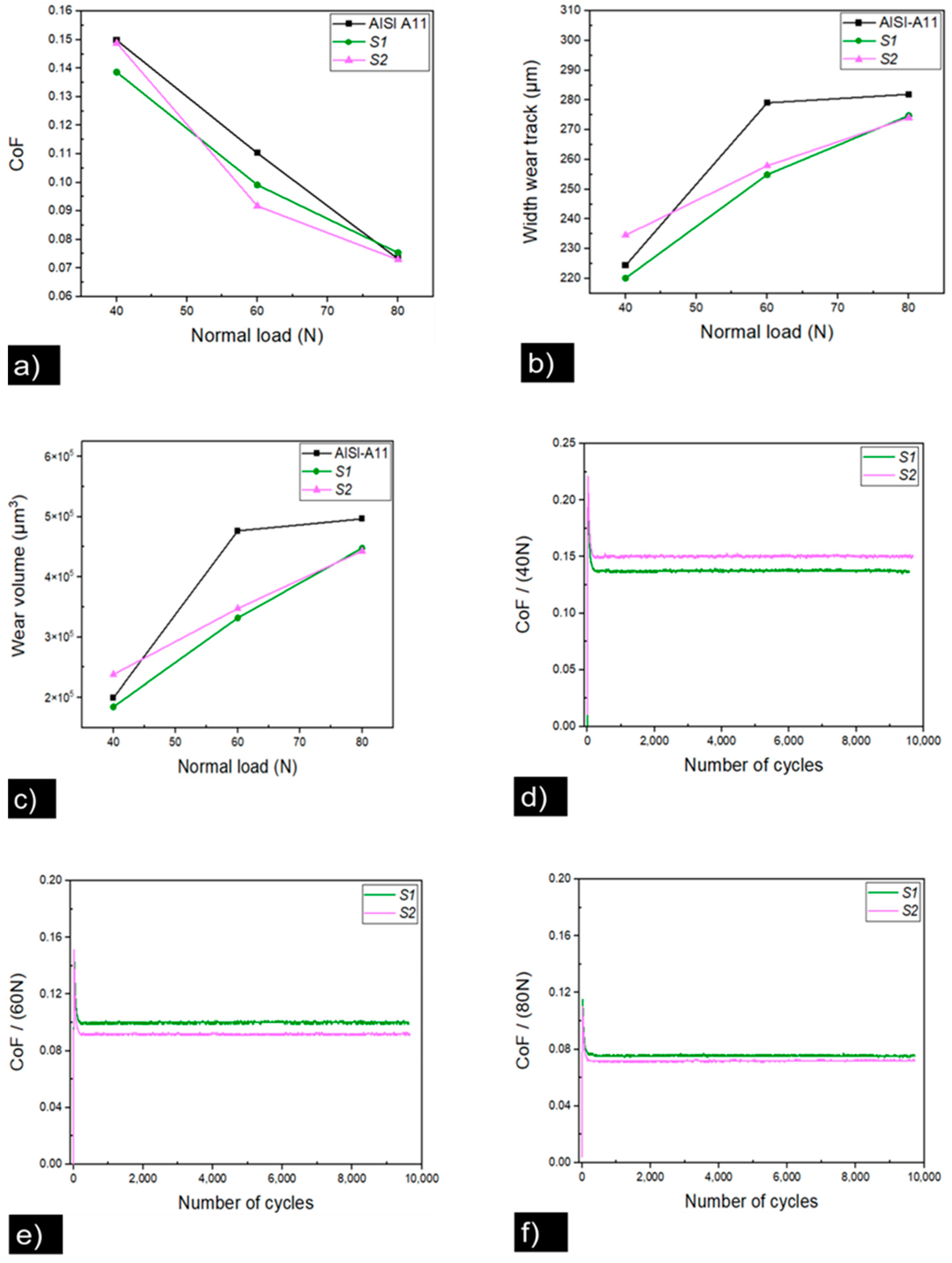

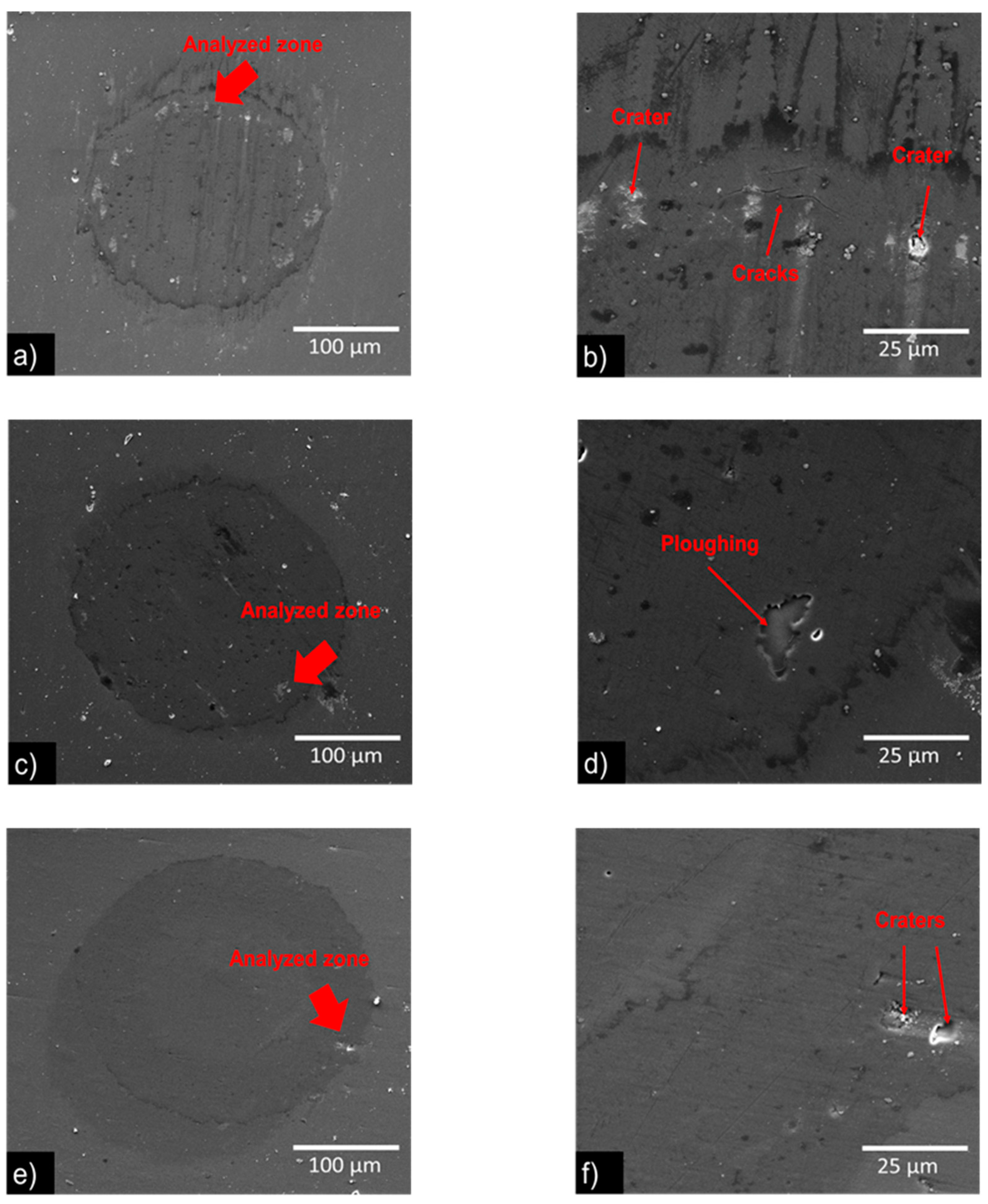
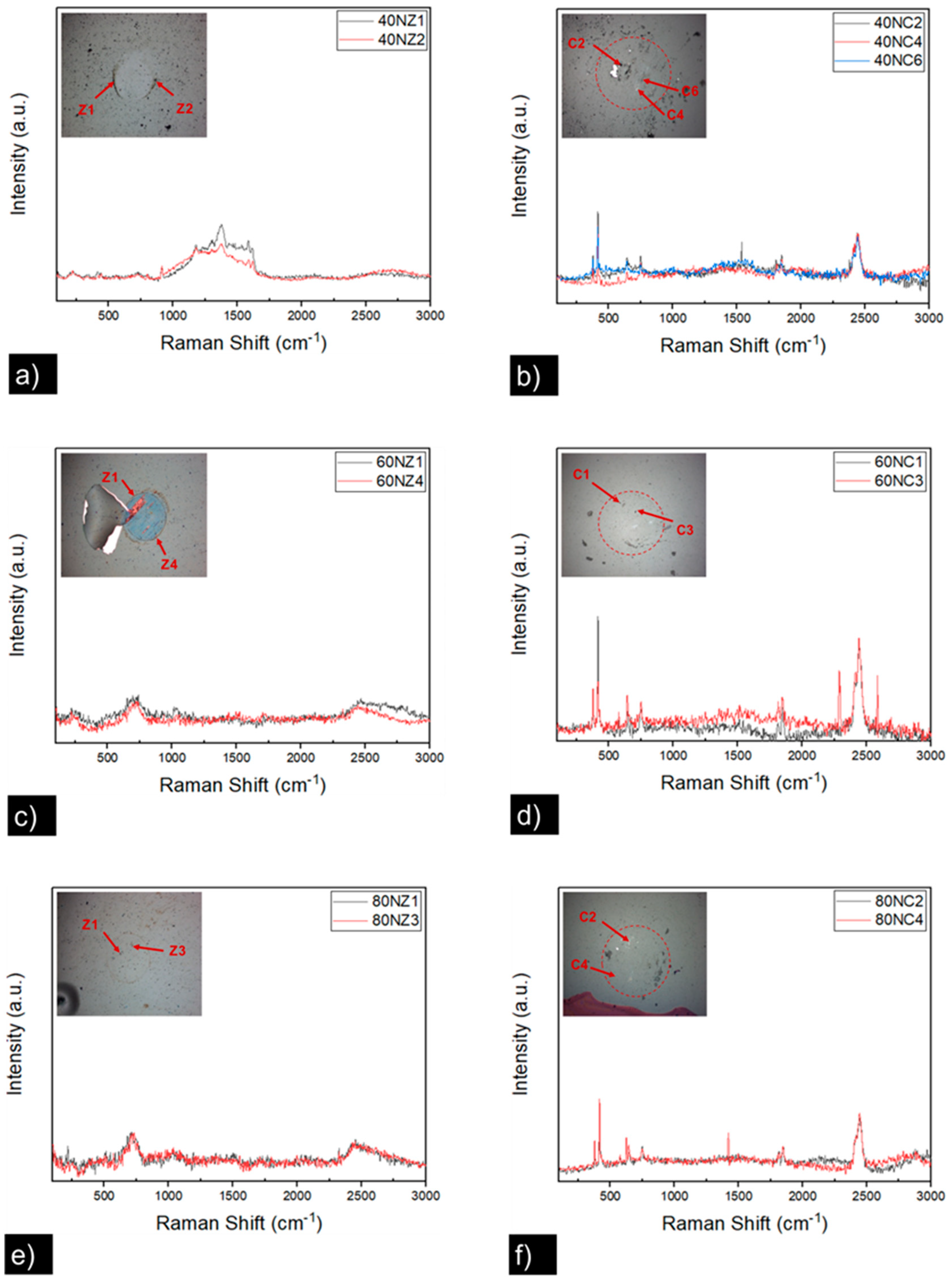
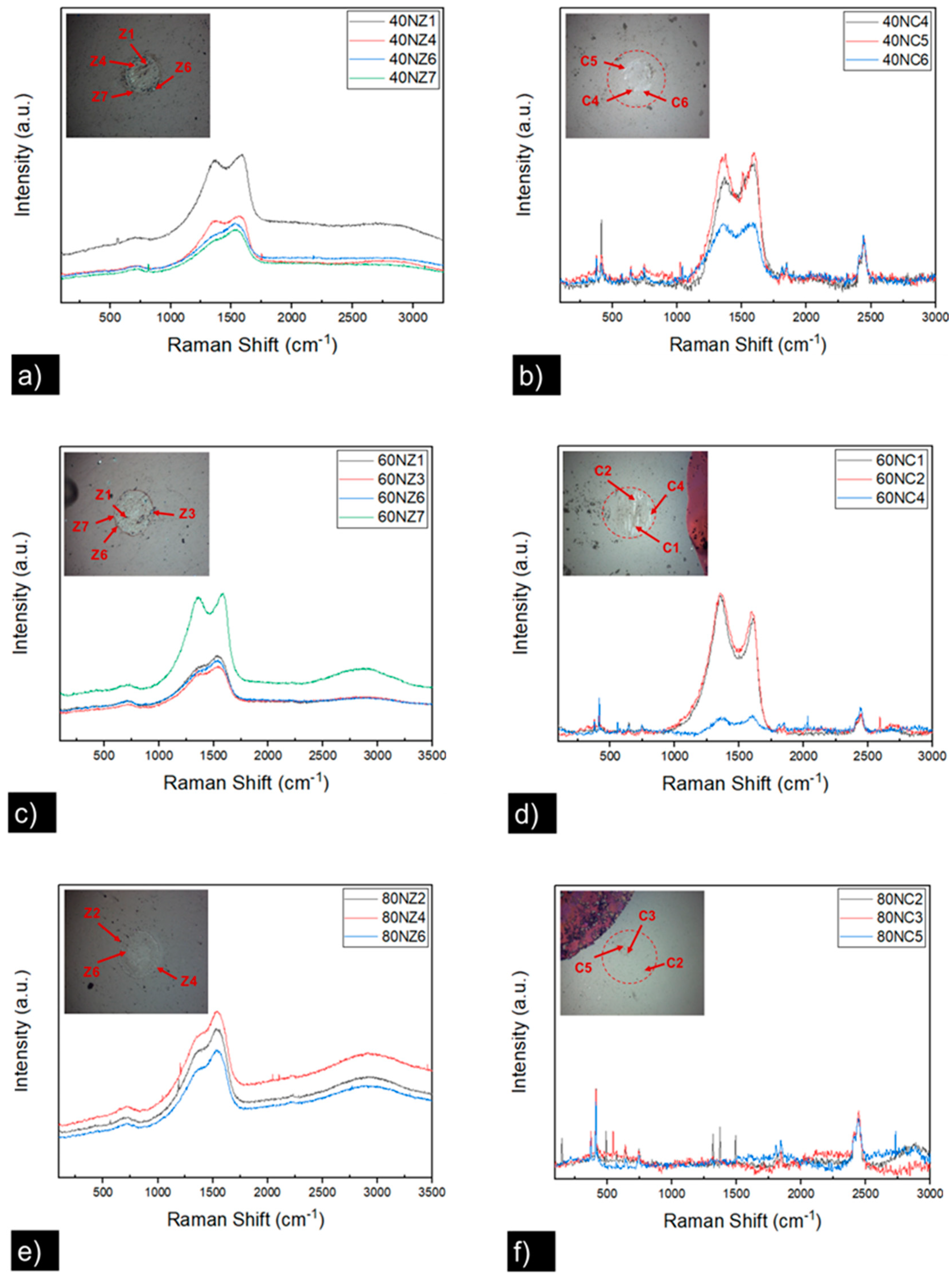

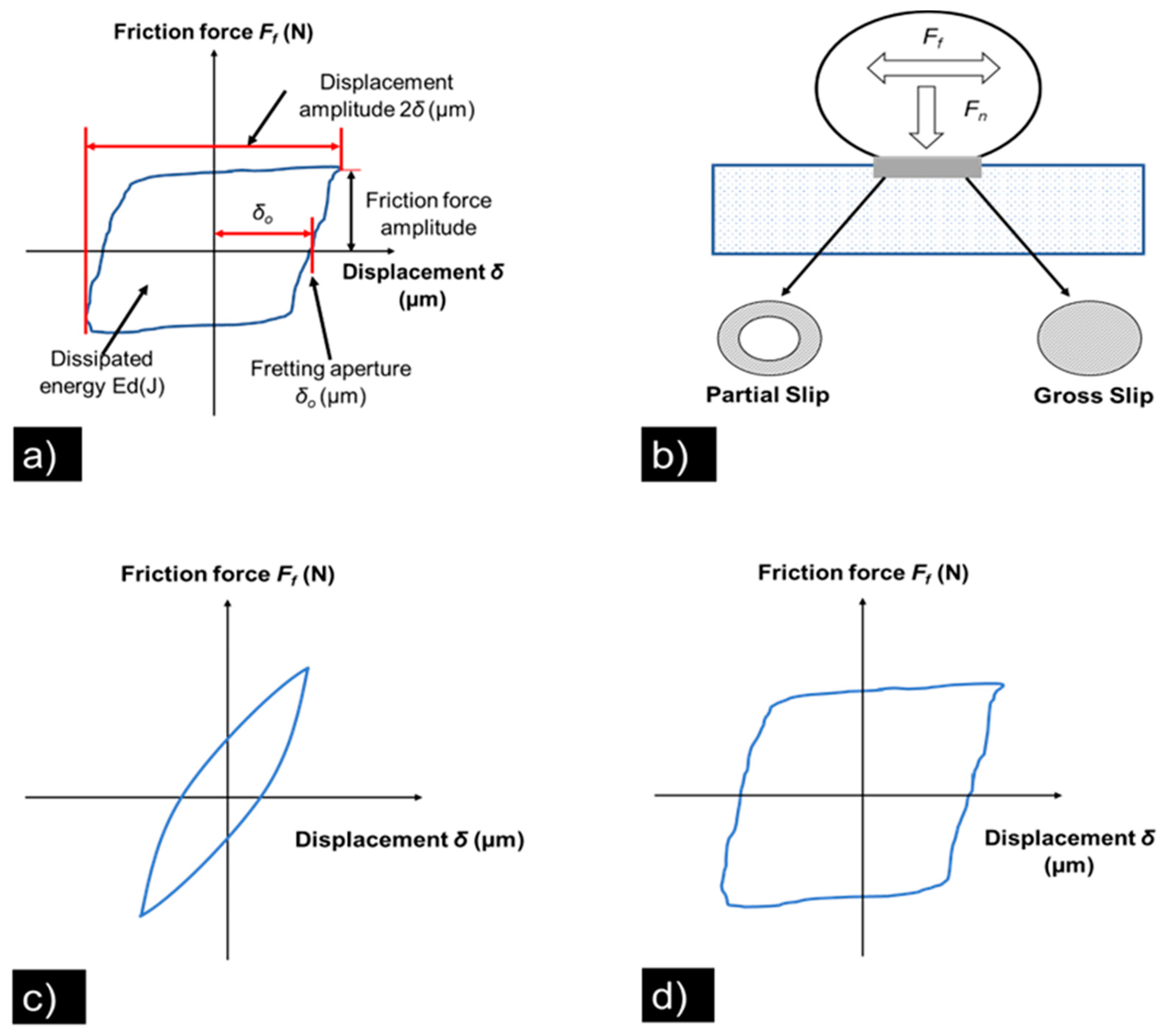
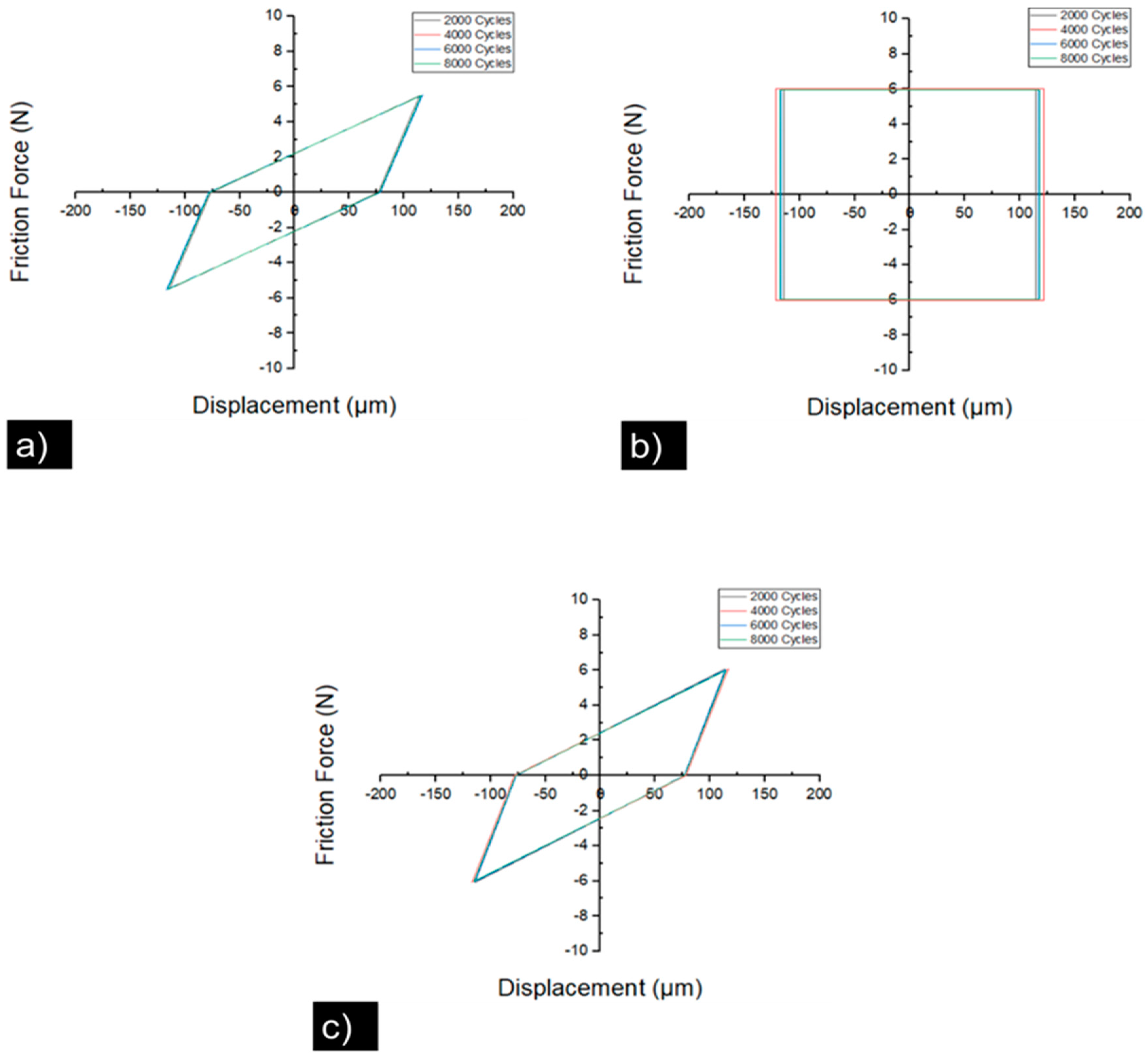
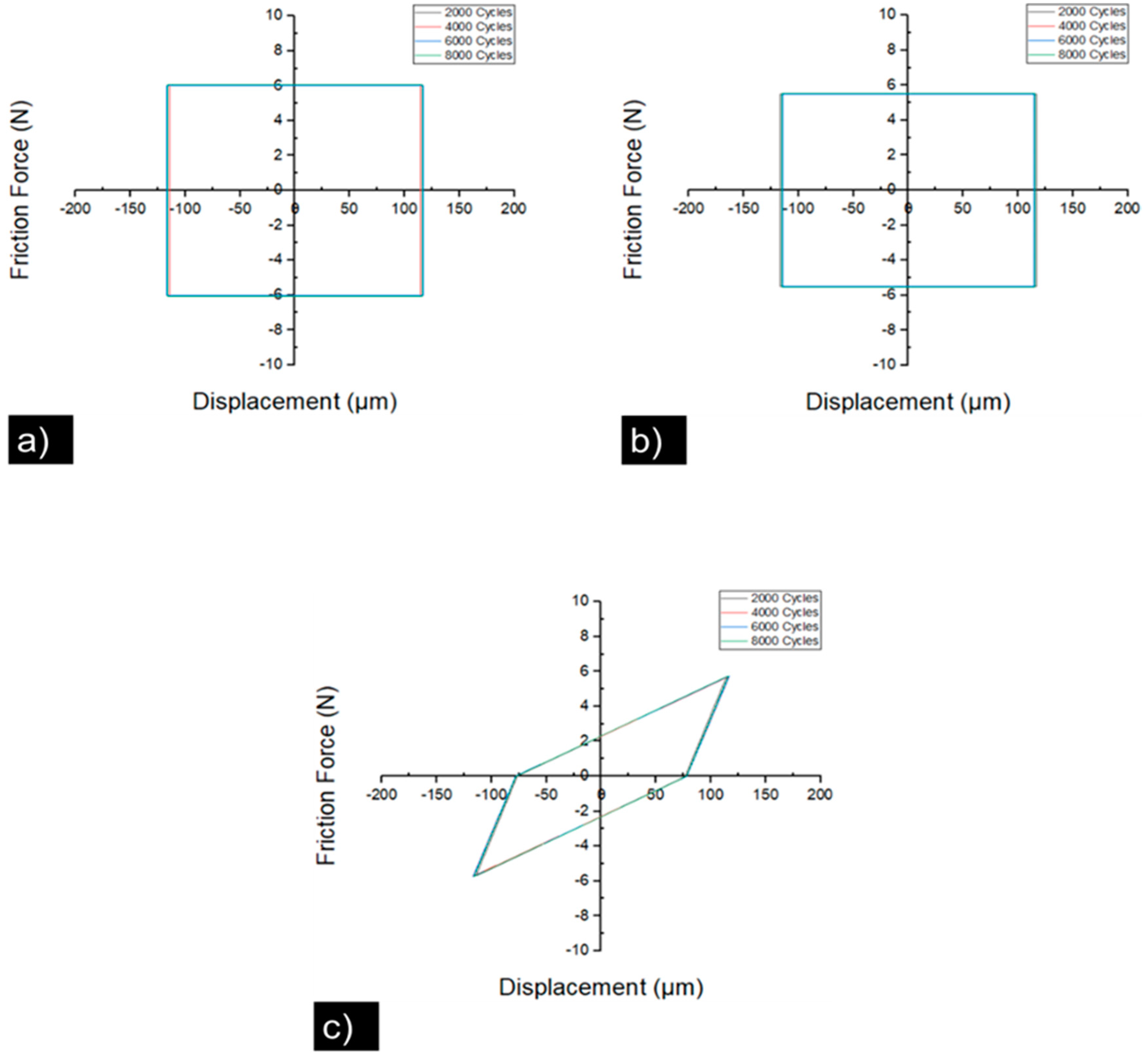
| Sample ID | Layer | Pulse Width (µs) | Frequency (Hz) | Voltage (V) | Peak Current (A) | Thickness/Period (nm) | Time (min) | |
|---|---|---|---|---|---|---|---|---|
| Periods | Composition | |||||||
| S1 | 4 | CrAl | 20 | 300 | 610 | 34 | 155 ± 4.0 | 12 |
| 4 | CrAlN | 20 | 300 | 420 | 50 | 235 ± 5.8 | 45 | |
| S2 | 3 | CrAl | 20 | 300 | 610 | 34 | 155 ± 4.0 | 12 |
| 3 | CrAlN | 20 | 300 | 420 | 50 | 235 ± 5.8 | 45 | |
| 1 top layer | CNx | 30 | 300 | 735 | 53 | 85 ± 3.1 | 13 | |
| Sample ID: | Atomic Composition (at.%) | ||
|---|---|---|---|
| Cr | Al | N | |
| S1 | 32.46 | 66.30 | - |
| S2 | 27.52 | 69.74 | - |
| Sample ID: | Thickness (µm) | Ra (µm) | H (GPa) | E (GPa) | Er | H/E | H3/E2 | H/Er | ER (%) |
|---|---|---|---|---|---|---|---|---|---|
| S1 | 1.5 ± 0.06 | 0.03628 ± 0.0058 | 23.08 ± 2.8 | 508 ± 39.3 | 373 | 0.045 | 0.047 | 0.0617 | 36.24 |
| S2 | 1.2 ± 0.05 | 0.02636 ± 0.0055 | 20.58 ± 1.8 | 397 ± 33.6 | 305 | 0.051 | 0.055 | 0.0674 | 45.75 |
| Sample ID: | v | µ | Lc1 (N) | Lc2 (N) | σc (GPa) | Gc (J/m2) |
|---|---|---|---|---|---|---|
| S1 | 0.22 | 0.086 | 0.729 | 0.859 | 0.5339 | 0.5329 |
| S2 | 0.19 | 0.056 | 0.434 | 0.665 | 0.3755 | 0.2539 |
| Sample ID: | Normal Load | ||
|---|---|---|---|
| 40 N | 60 N | 80 N | |
| S1 | 0.856 × 10−3 ± 1.21 × 10−5 | 0.705 × 10−3 ± 1.90 × 10−5 | 0.932 × 10−3 ± 1.06 × 10−5 |
| S2 | 0.699 × 10−3 ± 0.70 × 10−5 | 0.633 × 10−3 ± 0.65 × 10−5 | 0.890 × 10−3 ± 1.04 × 10−5 |
Disclaimer/Publisher’s Note: The statements, opinions and data contained in all publications are solely those of the individual author(s) and contributor(s) and not of MDPI and/or the editor(s). MDPI and/or the editor(s) disclaim responsibility for any injury to people or property resulting from any ideas, methods, instructions or products referred to in the content. |
© 2023 by the authors. Licensee MDPI, Basel, Switzerland. This article is an open access article distributed under the terms and conditions of the Creative Commons Attribution (CC BY) license (https://creativecommons.org/licenses/by/4.0/).
Share and Cite
Martínez-González, C.J.; Flores-Jiménez, M.F.; Bravo-Barcenas, D.I.; Jiménez-Alemán, O.; Flores-Martínez, M. Mechanical and Tribological Properties of the CrAl/CrAlN and CrAl/CrAlN-(a-CNx) Multilayers Deposited by HIPIMS. Coatings 2023, 13, 1344. https://doi.org/10.3390/coatings13081344
Martínez-González CJ, Flores-Jiménez MF, Bravo-Barcenas DI, Jiménez-Alemán O, Flores-Martínez M. Mechanical and Tribological Properties of the CrAl/CrAlN and CrAl/CrAlN-(a-CNx) Multilayers Deposited by HIPIMS. Coatings. 2023; 13(8):1344. https://doi.org/10.3390/coatings13081344
Chicago/Turabian StyleMartínez-González, Cecilio J., Max F. Flores-Jiménez, David I. Bravo-Barcenas, Omar Jiménez-Alemán, and Martín Flores-Martínez. 2023. "Mechanical and Tribological Properties of the CrAl/CrAlN and CrAl/CrAlN-(a-CNx) Multilayers Deposited by HIPIMS" Coatings 13, no. 8: 1344. https://doi.org/10.3390/coatings13081344





